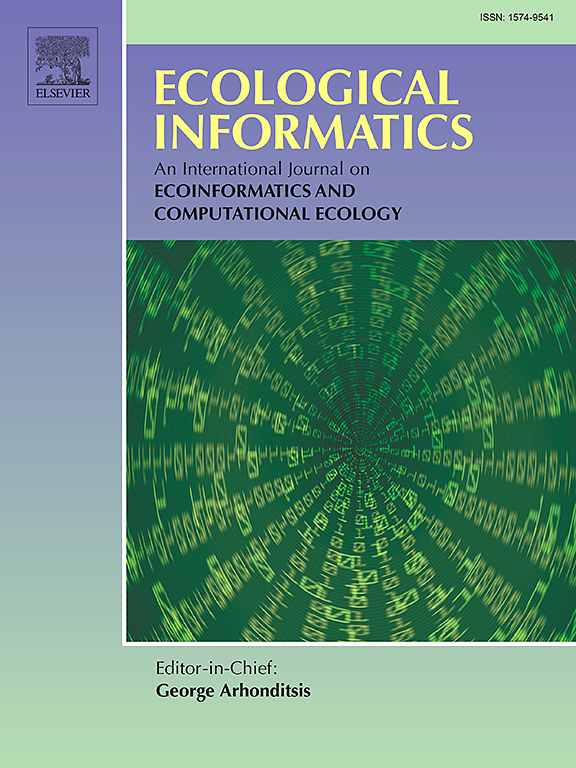归一化差分红-近红外-西红外光谱:用于绘制热带地区新开沼泽地的新型哨兵-2 号三波段光谱指数
IF 5.8
2区 环境科学与生态学
Q1 ECOLOGY
引用次数: 0
摘要
在热带地区,烧垦农业正在经历快速但被忽视的转型和变革,这使得全球碳预算和烧垦者可持续生计评估变得更加复杂。用于准确检测烧垦做法的遥感算法发展缓慢,无法对其动态进行年度更新。这主要是因为,使用中等空间分辨率的图像(≥30 米),要确定刀耕火种区的确切边界具有挑战性。迄今为止,基于光谱的方法在检测和绘制烧垦农业地图方面一直占主导地位,但哨兵-2 的潜力尚未得到研究。为了重建烧垦农业的年度信息,我们开发了一种新的哨兵-2 三波段光谱指数,即归一化红外、近红外和短波红外差值(NDRII),用于绘制热带地区新开垦的烧垦地。由于红光(可见光)、近红外和短波红外光谱波段组合(即 VNIR-SWIR 光谱)对热带高地旱季砍伐和焚烧造成的植被水分变化和热异常非常敏感,NDRII 能够准确划分出新开辟的沼泽地带。最新的 20 米地图有助于探究新开辟沼泽地的景观模式,并首次强调了它们在老挝的普遍性。NDRII 算法建立在哨兵-2 和大地遥感卫星-8(Landsat-8 Operational Land Imager)的 VNIR-SWIR 光谱技术基础上,通过整合使用时间叠加观测数据和现有 VNIR/SWIR 卫星图像的先进方法,进一步了解快速过渡和转变所导致的景观模式和干扰的动态变化,有助于重建热带沼泽地的历史数据集。本文章由计算机程序翻译,如有差异,请以英文原文为准。
Normalized Difference Red-NIR-SWIR: A new Sentinel-2 three-band spectral index for mapping freshly-opened swiddens in the tropics
Swidden agriculture is undergoing a rapid but overlooked transition and transformation in the tropics, complicating global carbon budgeting and sustainable livelihood assessment of swiddeners. Remotely sensed algorithms for accurately detecting swiddening practices have been slowly developed to generate annual updates on their dynamics. This is primarily because, using medium spatial resolution imagery (≥30 m), it is challenging to identify the exact boundary of swidden patches. Spectral-based approaches have by far dominated the detection and mapping of swidden agriculture, but the potential of Sentinel-2 has not been examined. To reconstruct annual information of swidden agriculture, a new Sentinel-2 three-band spectral index, i.e., the Normalized Difference Red, Near-infrared (NIR), and Shortwave-infrared (SWIR), or NDRII, has been developed to map freshly-opened swiddens in tropical regions. As Red (visible), NIR, and SWIR spectral band combinations (i.e., the VNIR-SWIR spectroscopy) are sensitive to vegetation-moisture variations and thermal anomalies caused by slash and burn in tropical uplands during the dry season, NDRII delineates exact patches of freshly opened swiddens. The latest 20-m map facilitates probing into the landscape patterns of newly opened swiddens and underlines their prevalence in Laos for the first time. Established within the VNIR-SWIR spectroscopy of Sentinel-2 and Landsat-8 Operational Land Imager, the NDRII algorithm contributes to reconstructing historical datasets of tropical swiddens via integrating state-of-the-art approaches that use temporally stacked observations with available VNIR/SWIR satellite imagery and further understanding the dynamics of landscape pattern and disturbance due to rapid transition and transformation.
求助全文
通过发布文献求助,成功后即可免费获取论文全文。
去求助
来源期刊

Ecological Informatics
环境科学-生态学
CiteScore
8.30
自引率
11.80%
发文量
346
审稿时长
46 days
期刊介绍:
The journal Ecological Informatics is devoted to the publication of high quality, peer-reviewed articles on all aspects of computational ecology, data science and biogeography. The scope of the journal takes into account the data-intensive nature of ecology, the growing capacity of information technology to access, harness and leverage complex data as well as the critical need for informing sustainable management in view of global environmental and climate change.
The nature of the journal is interdisciplinary at the crossover between ecology and informatics. It focuses on novel concepts and techniques for image- and genome-based monitoring and interpretation, sensor- and multimedia-based data acquisition, internet-based data archiving and sharing, data assimilation, modelling and prediction of ecological data.
 求助内容:
求助内容: 应助结果提醒方式:
应助结果提醒方式:


